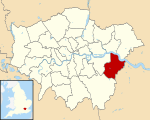Crook Log

Crook Log is a locality around Watling Street (A207) within the London Borough of Bexley. It lies at the western edge of Bexleyheath along the boundary with Welling. All three places merge with no clear separation points. Crook Log is approximately 10.9 miles (17.5 km) east south-east of Charing Cross, the traditional centre of London. Key landmarks are the Crook Log Inn, now a licensed restaurant, on the southern side of the A207 and a sports centre on the northern side. In 2005 the Crook Log leisure centre was expanded to include an eight–lane 25 metre indoor swimming pool, a teaching pool and changing facilities. The new centre was opened by Her Majesty the Queen on 26 July 2005. An existing and long established swimming pool across the road, at that time known as Splashworld, was then demolished. The site was redeveloped with 52 apartments and the complex was named "The Old Baths". Other nearby public amenities include a youth centre and an adult education centre. Also in the area are Crook Log Primary School and The Crook Log guest house. An amateur theatre called the Edward Alderton Theatre is in Crook Log. Actor Roger Moore and world heavyweight boxing champion Lennox Lewis are former residents of this area.
Excerpt from the Wikipedia article Crook Log (License: CC BY-SA 3.0, Authors, Images).Crook Log
Crook Log, London Blendon (London Borough of Bexley)
Geographical coordinates (GPS) Address Nearby Places Show on map
Geographical coordinates (GPS)
| Latitude | Longitude |
|---|---|
| N 51.459 ° | E 0.128 ° |
Address
Crook Log
Crook Log
DA6 8EG London, Blendon (London Borough of Bexley)
England, United Kingdom
Open on Google Maps








